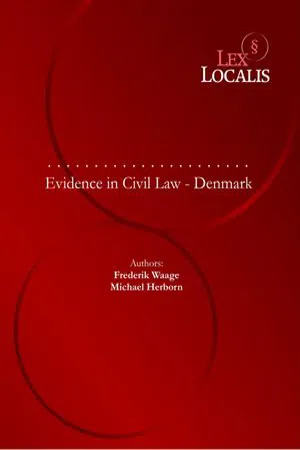
- English
- PDF
- Available on iOS & Android
Evidence in Civil Law - Denmark
About this book
Danish civil procedure is based on a number of procedural law principles that affect the taking of evidence, including the principle of party presentation, the principle of disposition, and the principle of free assessment of evidence. The nature of Danish procedural law tends towards the adversarial model rather than the inquisitorial model. Evidence is taken during the hearing and the principle of directness applies to the procedure. Danish civil procedure is governed by the 1916 Administration of Justice Act, which was originally strongly influenced by German law. The role of the judge is to lead the process and also to intervene in proceedings when uncertainty exists, rather than just to facilitate the process by ensuring the parties abide by the laws of civil procedure.
Frequently asked questions
- Essential is ideal for learners and professionals who enjoy exploring a wide range of subjects. Access the Essential Library with 800,000+ trusted titles and best-sellers across business, personal growth, and the humanities. Includes unlimited reading time and Standard Read Aloud voice.
- Complete: Perfect for advanced learners and researchers needing full, unrestricted access. Unlock 1.4M+ books across hundreds of subjects, including academic and specialized titles. The Complete Plan also includes advanced features like Premium Read Aloud and Research Assistant.
Please note we cannot support devices running on iOS 13 and Android 7 or earlier. Learn more about using the app.
Information
Table of contents
- Evidence in Civil Law – Denmark by Frederik Waage & Michael Herborn
- Abstract
- Keywords
- Frederik Waage Michael Herborn: Author Biography
- Michael Herborn: Author Biography
- Preface
- Contents
- Part I
- 1 Introduction
- 2 Fundamental Principles of Civil Procedure
- 2.1 Party Presentation Principle and Principle of Investigation
- 2.2 Principle of Free Disposition
- 2.3 Principle of Concentration
- 2.4 No Inquisitorial Procedure in Danish Law
- 2.5 The Role of the Judge
- 2.6 The Contradictory Principle
- 2.7 Principles of Evidence Taking
- 2.8 Principles that Guides the Judge in the Taking of Evidence
- 2.9 The Contradictory Principle
- 2.10 Failure to Appear Before the Court
- 2.11 Principle of Right to Oral Stage
- 2.12 Principle of Directness
- 2.13 Principle of Public Hearing
- 3 General Principles of Evidence Taking
- 3.1 Free Assessment of Evidence
- 3.2 The Principles of Material and Formal Truth
- 3.3 Discovery
- 3.4 The Right to Put Forward New Facts and Evidence (ius novorum)
- 4 Evidence in General
- 4.1 Interrogation of a Party
- 4.2 Duty to Speak the (Full) Truth
- 4.3 Burden of Proof
- 4.4 Iura novit curia
- 4.5 Re-opening of the Pre-trial Procedure
- 4.6 Written Evidence
- 4.7 Electronic Communication
- 5 General Rule on the Burden of Proof
- 5.1 Duty to be a Witness
- 5.2 Related Persons
- 5.3 Procedure as to Witnesses
- 5.4 Obtaining Evidence from Witnesses
- 5.5 Written and Oral Statements
- 5.6 Taking of Evidence
- 5.7 Identification of Evidence
- 5.8 Procedure for Video Communication
- 5.9 Expert Witnesses
- 6 Costs and Language
- 6.1 Use of Interpreters
- 7 Unlawful Evidence
- 7.1 The Principle of Free Evidence
- Part II – Synoptical Presentation
- 1 Synoptic Tables
- 1.1 Ordinary/Common Civil Procedure Timeline
- 1.2 Basics about Legal Interpretation in Denmark Legal System
- 1.3 Functional Comparison
- References